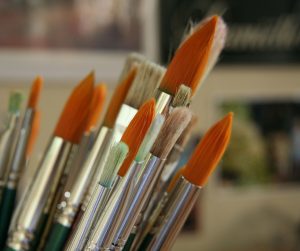5 Things You Need to Know About Brushes
 If it looks like a kids’ craft brush, it probably is. The cost of a brush is often an indicator of quality but it isn’t always a guarantee. You have to examine the brushes carefully when making a selection. If the bristles look like plastic or like they have all been cut off blunt at the same time that is not a brush intended for an art student or for an artist. Some brush handles break more easily because they are made with softer wood than others. Some people love brushes with plastic handles but they are not biodegradable so that should be considered and it doesn’t mean the rest of the brush is great. You have to look beyond the handle material. How well is the ferule crimped? Multiple crimps can help secure the handle but the handle may still come loose. If that happens all is not lost – a dab of the glue that says it will hold metal and wood (or plastic) will fix it. The ferrule of a high quality brush should not be rough around the cut edge of the ferrule where it meets the handle. Don’t leave your brush soaking it water that reaches up to the handle – – – that will eventually cause the paint to flake off the handle and it may also eventually cause the eroding of the glue that secures the bristles.
If it looks like a kids’ craft brush, it probably is. The cost of a brush is often an indicator of quality but it isn’t always a guarantee. You have to examine the brushes carefully when making a selection. If the bristles look like plastic or like they have all been cut off blunt at the same time that is not a brush intended for an art student or for an artist. Some brush handles break more easily because they are made with softer wood than others. Some people love brushes with plastic handles but they are not biodegradable so that should be considered and it doesn’t mean the rest of the brush is great. You have to look beyond the handle material. How well is the ferule crimped? Multiple crimps can help secure the handle but the handle may still come loose. If that happens all is not lost – a dab of the glue that says it will hold metal and wood (or plastic) will fix it. The ferrule of a high quality brush should not be rough around the cut edge of the ferrule where it meets the handle. Don’t leave your brush soaking it water that reaches up to the handle – – – that will eventually cause the paint to flake off the handle and it may also eventually cause the eroding of the glue that secures the bristles.- The hair or bristle type makes a difference. Some bristles carry more water, some have more spring, some will yield a smoother stroke, some are better for blending. Every brush is not suitable for all paints – and some are only for one specific type of paint. And yes, most brushes – especially those with natural hair will have some sort or shedding or hair loss – that is normal and you just have to deal with it.
- You need to have the right brush. We all know having the right tool makes a job easier. Teachers suggest certain brushes for certain tasks because that is what worked well for them. It doesn’t mean that nothing else will work but if you are having problems and not using the same sort of brush that could certainly be part of the problem and should be considered.
- Brushes require care – you can count on it. Just like water will damage the handles, improper cleaning and lack of care will eventually ruin the bristles. Take care of your brush investment by rinsing your brushes and at the end of a painting day thoroughly cleaning the bristles until no color comes out. Remember to stroke and gentle press as you clean brushes – mashing and scrubbing will cause damage. Store the brushes lying down until they are dry. Once they are dry you can stand them on the handle ends if you like that. Always protect the bristles when storing and transporting so they will not get bent or otherwise damaged.
- Is there really any such thing as a miracle brush? I guess that depends on who you ask! Some brushes seem to work wonders once they are broken in and are not quite so stiff. Some are task specific and there are all kinds of specialty brushes that have a very limited use but if you use them and they work for you that is what counts! A brush can be worth every cent of its cost and them some when you know what you can expect and it performs well for you. Using a brush that is the right size for what you are doing is worth the cost of investing in a variety of sizes. A small brush in a large area will make the painting process take a lot longer and you may have a difficult time getting the painting to look the way you want. It’s a miracle how much faster you can work with a larger brush and still get better results.
In conclusion, all brushes are not created equally. I recommend that you make your selections carefully as you consider your needs, buy good brushes – the best you can afford and then take good care of them!
Visit our online art store at www.artapprenticeonline.com for quality brushes and other art products!

Leave a Reply